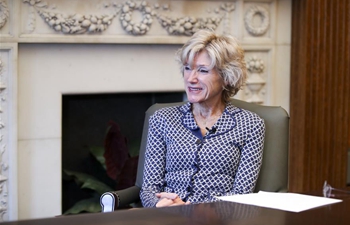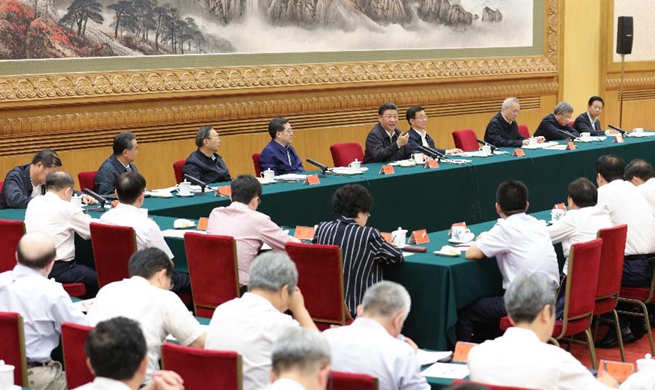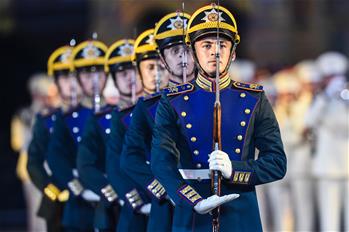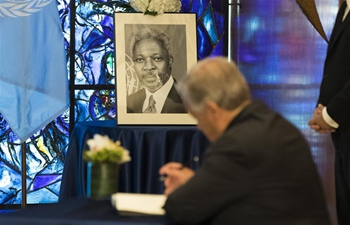SEOUL, Aug. 28 (Xinhua) -- South Korea unveiled the 2019 budget plan Tuesday that would mark the biggest defense budget growth in 11 years to modernize the military in accordance with the scheduled reduction of troops.
Defense budget for 2019 was 46.7 trillion won (42 billion U.S. dollars), up 8.2 percent from this year's defense cost. It marked the biggest increase since 2008 and nearly doubled the average growth rate of 4.4 percent between 2010 and 2017.
Budget to maintain the current defense capability and enhance soliders' welfare rose 5.7 percent to 31.3 trillion won (28.2 billion U.S. dollars) for next year.
The on-year growth for budget to modernize the military and improve defense capability was 13.7 percent, tripling the average rising rate of 4.4 percent between 2010 and 2017. Such budget was set at 15.4 trillion won (13.9 billion U.S. dollars).
Under the Defense Reform 2.0, the military planned to reduce the number of active-duty troops to 500,000 by 2022 from the current 618,000.
The increased defense budget will be spent on developing reconnaissance satellites, missile interceptors and ballistic missiles, while strengthening maneuverability and command and control.
Research and development (R&D) budget to develop high-tech weapons, such as drones and robots, was 3.1 trillion won (2.8 billion U.S. dollars) for next year.
Budget of 17.2 billion won (15.4 million U.S. dollars) was earmarked for inter-Korean defense cooperation, including the joint excavation of the remains of soldiers killed during the 1950-53 Korean War and the removal of land mines in the demilitarized zone (DMZ) dividing the two Koreas.
The allocation was aimed at implementing the Panmunjom Declaration, which was signed by South Korean President Moon Jae-in and Kim Jong Un, top leader of the Democratic People's Republic of Korea (DPRK), following their first summit on April 27 at the border village of Panmunjom.
Under the declaration, the two leaders agreed to completely denuclearize the Korean Peninsula, stop all hostile acts and increase cooperation.
To brace for the expanded inter-Korean economic cooperation, relevant budget of the unification ministry in charge of inter-Korean affairs jumped 46 percent to 504.4 billion won (454.5 million U.S. dollars).
The budget would be spent mainly on modernizing and connecting the railways and roads across the inter-Korean border in accordance with progress in the denuclearization process. A joint survey for the railway and road projects has been underway between the two Koreas.
Meanwhile, the 2019 budget plan was mainly focused on creating quality jobs and expanding social welfare.
The 2019 budget was set at 470.5 trillion won (424 billion U.S. dollars), up 9.7 percent from this year's 428.8 trillion won (386 billion U.S. dollars), according the Ministry of Economy and Finance.
It was confirmed at a cabinet meeting chaired by President Moon. By law, the budget plan was set to be submitted to the National Assembly by the end of this month for review.
The 9.7-percent growth rate would be the biggest since 2009 when the government adopted an expansionary fiscal spending to tackle the ramifications from the 2008 global financial crisis.
The expansionary fiscal expenditure aimed to boost job creation, expand social safety net, reduce income inequality, bolster innovative growth and reinvigorate the economy, according to the ministry.
Finance Minister Kim Dong-yeon, who doubles as deputy prime minister for economic affairs, stressed the need to create jobs, saying jobs would be created by expanding a fiscal spending after considering the recent increase in tax revenue.
A whopping 23.5 trillion won (21.2 billion U.S. dollars) was allotted to the 2019 budget for job creation, the biggest ever recorded by the economy. It was up 22 percent from this year's job-creating budget.
With the budget, the government aimed to create more than 900,000 jobs, especially for the disadvantaged group in finding a job that includes the elderly, women and the disabled.
The record high of 162.2 trillion won (146.2 billion U.S. dollars) was earmarked for the 2019 welfare budget, up 12.1 percent this year's welfare cost. It accounted for 34.5 percent of the total budget, posting the highest portion.
Education budget increased 10.5 percent to 70.9 trillion won (63.9 billion U.S. dollars). The combination of welfare and education budget took up almost half of the country's total budget in 2019.
To bolster innovative growth, 18.6 trillion won (16.8 billion U.S. dollars) was allocated to investment in the mid-sized enterprises and the energy sector. It was up 14.3 percent from this year's budget.
Research and development (R&D) budget for next year rose 3.7 percent to 20.4 trillion won (18.4 billion U.S. dollars).
Budget for public works alone went down. Social overhead capital (SOC) fell 2.3 percent over the year to 18.5 trillion won (16.7 billion U.S. dollars) for next year.
The country's gross income was forecast to expand 7.6 percent from a year earlier to 481.3 trillion won (433.7 billion U.S. dollars) in 2019, including 299.3 trillion won (269.7 billion U.S. dollars) in national tax revenue.













